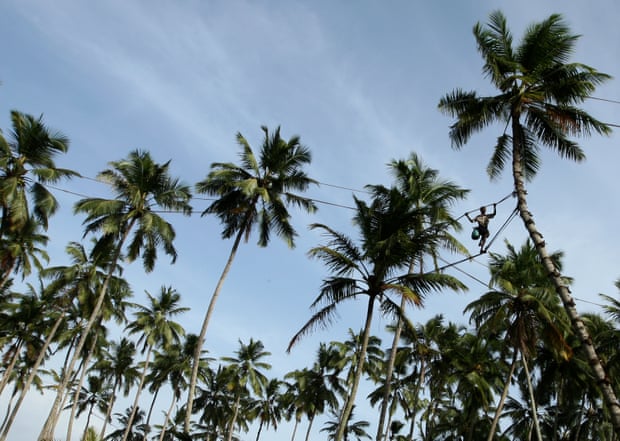JAFFNA: The palmyra palm tree with its wide fan leaves is a distinctive and common sight across Jaffna, northern Sri Lanka, thriving in the arid conditions.
Kutty, who goes by only one name, is a “toddy tapper”. Climbing the palms with his clay pot, he collects sap from the flower heads at the top of the great trees, which can grow to more than 30 metres (90ft). The sap is fermented to make toddy, an alcoholic drink also known as palm wine.
He shaves the tips off the flowers, tying the pot’s rope handle in place to collect the fluid. It’s meticulous and risky work. Afterwards, he takes the precious juice to the collection centre, just like thousands of other toddy tappers. There are about 11 million palmyra or borassus trees dotting the landscape across the country, but despite its many uses, from making brooms to ice-cream, very few were being utilised – until recently.
With such a small market for toddy, co-operatives would cap the amount they bought and the traditional skills of the tappers were being lost, as the sap brought in little profit. These skills were especially neglected in the Jaffna peninsula during the long civil war, which raged between 1983 and 2009.

It didn’t help that toddy was seen as a poor man’s drink. The clay pots used to collect the sap were unhygienic, bottles in which the drink was sold were dirty, and the manufacturing equipment in factories was outdated.
Suganthan Shanmuganathan had fled his native Jaffna for Canada during the civil war but returned 25 years later in 2014 with his family. He had established a successful drinks business when he heard the Varany Palmyrah Arrack Co-operative was in danger of collapse, and he began to see the potential in a dying industry.

“I realised the difficulties faced by societies and tappers. I wished to positively change the living standards of toddy tappers, their families, especially young children, while uplifting this marginalised society,” says Shanmuganathan.
“I looked at the existent process and gave my suggestions based on my expertise of the manufacturing process I had learned in Canada to boost and uplift the palmyra industry.”
Within a few years, the industry has transformed. Today, about 4,000 people work as toddy tappers. Quality has drastically improved and manufacturing equipment has been upgraded.
“Our industry was going nowhere. We were only allowed to bring 30 litres a day by the co-operative,” says Kutty.
“This meant my monthly income was around 18,000 Sri Lankan rupees (£70). Shanmuganathan removed the limit on quantity but he insisted on quality. This ensured that only the best was brought in by the tappers. Our income increased to around 190,000 Sri Lankan rupees.
“Toddy tappers who were living a hand-to-mouth existence now have a comfortable life. This has changed many lives, not just for us and our children, but our extended families and our villages.”
In the pandemic, the Palmyrah Research Institute and Alerics, a Sri Lankan ice-cream company, launched ice-cream made from the fruit pulp.
“I have over 40 years experience in the palmyra industry and was very sad to see it decline over the years. No one seemed to understand the value of the palmyra tree and its benefits. I was also saddened since all the research and knowledge I had acquired in my lifetime was going to waste,” says Thiyagarajah Panneerchelvam, head technician at the state-backed Palmyrah Development Board. He credits Shanmuganathan with reviving the industry and “also making sure that local knowledge and expertise does not disappear with my generation”.
Jekhan Aruliah, co-founder of a Jaffna management consultancy that works with Shanmuganathan, agrees.
“This has not been easy for him. He has had to change the work culture of the palmyra co-operatives, which have been stubbornly stagnant for decades. Palmyra is the iconic tree of the north, he is turning it into a pillar of northern economic success,” he says.
“While uplifting the lives of thousands of families, we are creating an industry which is environmentally friendly and aims for zero waste. We envisage that the growth in the palmyra industry will lead to growth in many other industries […] The ripple effect is huge.”
© The Guardian




